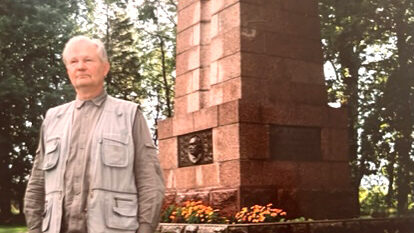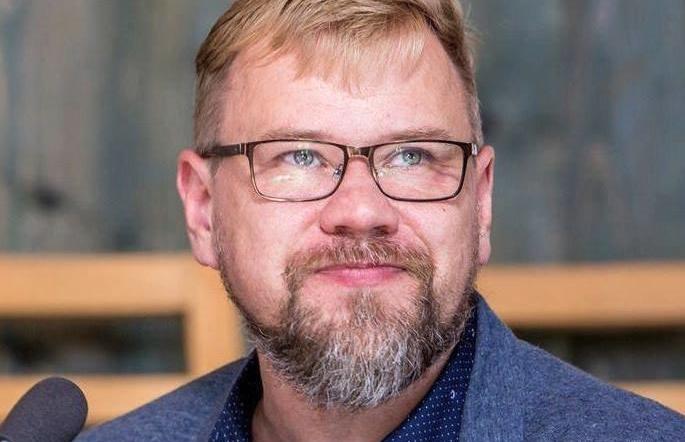In Tõrva the miilits (police) had been called at 7:20 a.m. by the night watchman of the local consumers co-operative who in turn had been informed by workers of the co-op's cafeteria about a strange flag that had been hoisted onto the flagpole on top of the Tõrva Workers Municipal Council building's tower. The night watchman saw from afar that the flag was a strange one and phoned the miilits immediately.
Now two local miilits stalwarts were standing and staring at a clear political provocation. The tower of the building representing Soviet power locally was majestically flying the flag of independent Estonia. They were helpless. Though they had obtained a key to the building, they couldn't open the door leading to the tower.
After various unsuccessful attempts at breaking the door down, an axe from the head of the municipal government broke through. Someone had secured the door from the other side with a wooden ladder.
But now the miilits was confronted by another provocation pinned to the other side of the door with thumbtacks. It was a warning – “Mined”! The miilits saw this just as a hollow threat and proceeded to climb the tower and remove the Estonian flag with its slender flag pole and threw them into the street. By this time the secretary of the local Council had arrived, who ripped the Estonian flag from the pole, fixed a Soviet flag in its place and had it returned to the top of the tower. The symbol of Soviet power which had been temporarily violated had been returned to its rightful place.
The KGB did not treat what had happened lightly. Interrogated were all members of the municipal Council and the locksmith who had made a new set of keys for the building just a few days before. However, three teenage students became the prime suspects.
Toivo Rand, Ernst Kangur, Olev Lõndso, graduating year students in high school, were convinced that the 1st of May was the right day for pulling off such a public statement. They wanted something sensational to recall in the future, something that would drive the communist elite in the area into a panic.
The preparations were carefully undertaken. The cloth, die, thread and such were purchased in Valga, not in a local store. They sewed the flag on a grandmother's sewing machine some distance away. All surplus materials were burned. Before arriving at the municipal building the boys pulled on boots that had been soaked in petroleum so as to throw off any search dogs.
In a shower of wet snow at 11:00 PM on April 30th the operation was launched at the municipal hall. Lõndso had brought along a six meter wooden pole. Using the pole and an aspen growing at the side of the building two boys were able to make it to the roof. One remained below to warn of anyone approaching. It didn't take long for the red flag to be replaced by the historic blue, black and white shortly after midnight.
Back on the ground the boys went to a hiding place on a nearby hill, put on new boots and burned the petroleum-soaked footwear. This precaution was a key factor in not being caught since the dogs could not pick up any human scent.
So many were interrogated by the KGB that Lõndso and his compatriots were summoned a full two weeks later. Their interrogations were thorough, done in dark rooms with a piercing light shining into their eyes. They were threatened. Lõndso underwent a marathon session lasting ten and a half hours non-stop. The boys didn't buckle under, even when they were told individually that one of them had confessed. They didn't fall for it..
Their homes were searched and found were drawing paper, die for cloth and thread. Sewing machines in the area were examined to find the one which had sewed the flag. The KGB lab came to the conclusion that the sewing was done by individuals who had no experience in sewing. The found cloth die did not match the one used on the flag. The thread was the same but this wasn't sufficient to make a determination.
Since an office of a local state farm was also located in the building, the list of potential suspects was very large. The KGB established that a key to the building had been lost during a meeting of the state farm officials. New information was passed on by the KGB's network of agents in the state farm. Apparently a farm worker had bragged that May 1st would offer plenty of excitement and this diverted the KGB's attention to the state farm workers. This did not offer any results and the investigation was abandoned in December of 1964.
That is why the story has been relatively unfamiliar to the public. But a thick dossier (ERAF, 130 1.5315) in the national archives carried a thorough documentation of the events.
The prime suspects were the boys, but the KGB lacked sufficient evidence. The boys didn't reveal their secret to anyone, including family. The KGB targeted them primarily because Lõndso had a record. He had been caught in the Caucuses attempting to cross over into Turkey. But he was able to talk his way out of that situation by convincing them he got lost hiking.
Not until the regaining of independence did they talk. A half century later dr. Olev Lõndso, now the psychiatrist at the Põlva hospital reminisced: “Me and my school mates thought we'd be graduating soon but with nothing significant to remember about our school years. We had just read “Nimed marmortahvlil” and “Eesti rahva kannatuste aasta” (forbidden books). Our parents and relatives still remembered the free and independent republic. That helped us make a decision.”
“The morning after the flag was raised, I was curious and told my mother I was going to the store to buy bread,” recalls Lõndso. “I met our Russian language teacher on the street who shouted that the fascist flag had been raised. She said the regime had changed and that she had to flee immediately. I wanted to tell her that the fascist flag was the red one.”
Laas Leivat




